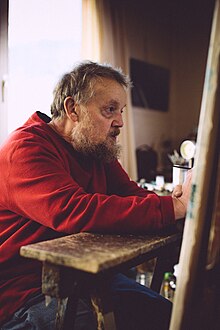Willi Oertig
Willi Oertig (born February 25, 1947 in Zurich ) is a Swiss painter who is assigned to realism .
Life
Oertig spent his childhood and youth in Zurich under difficult circumstances. Numerous moves by the family of five uprooted the young Oertig, which had an impact on his later work. After several aborted apprenticeships, he finally completed and finished an apprenticeship as a plan printer. His drawing talent was already noticed by his mother, who gave him a box of oil paints during his apprenticeship . Oertig's discovery as a painter dates back to 1971, when he was able to present his art to the general public for the first time at an exhibition in the halls of the Züspa.
Oertig spent the seventies and eighties in Fägswil near Rüti in the Zurich Oberland. The family moved to Kümmertshausen in the canton of Thurgau in 1989 . In 1994 the company moved to a former guest house in Kradolf . While his studio was initially in a factory hall of the former Ernst pasta factory, Oertig now works in his own studio right next to his house. According to his own statements, Oertig has now painted over a thousand pictures and sold all of them. His real art is to “sell” the pictures.
plant
Oertig is an autodidact . He described the processing of his uprooted youth as the engine of his passion for painting, with abandonment in the pictures being the central message. Occasionally Oertig is compared to Adolf Dietrich , a naive artist of the early 20th century. In his early work there are also parallels with painters like Emerik Fejes and Louis Vivin .
Oertig was discovered in the early 1970s with Naive Art. Since the 1980s he has used his own photos as templates, which gradually brought his work closer to realism. Oertig's best-known motifs are petrol stations, abandoned jetties, empty train stations or underground stations.
In 2013, the Thurgau Art Museum honored Oertig with a large retrospective of his work.
Well-known paintings
- Güterbahnhof, Zurich, 1971. Private ownership.
- Palmenhaus, Vienna, 1979. Private ownership.
- Métro Station Montparnasse-Bienvenue, Paris, 1981. Private ownership.
- Aral gas station, Erlen, 1994. Andy Jllien Fine Art, Zurich.
- Strom Thur 1, 1997. UBS Art Collection.
- At the weir, Kradolf, 1999. Thurgau Art Museum.
- Ship, Lake Maggiore, 2006. Thurgau Art Museum.
Exhibitions
- 1971 First jury-free exhibition, Züspahallen, Zurich
- 1972 Zurich artist in the Helmhaus, Zurich
- 1973 International Naive Art, Lugano
- 1974 to 1991 Regular exhibitions at the Wolfsberg Art Salon , Zurich
- 1976 town house, Uster
- 1980 Helmhaus, Zurich
- 1987 Priska Meier Gallery, Zell
- 1988 town house, Uster
- 1993 Kunstverein Frauenfeld
- 1994 to 2005 Regular exhibitions in the Andy Jllien Gallery, Zurich
- 1995 UBS training center, Wolfsberg, Ermatingen
- 1996 to 2007 Regular exhibitions at the Christine Brügger Gallery, Bern
- 1997 IG Halle, Rapperswil
- 1997 artist from Eastern Switzerland, St.Gallen
- 1999 Schönenberger Gallery, Kirchberg
- 1999 Green Door Gallery, Uznach
- 2001 Art Museum Thurgau (group exhibition), Ittingen Charterhouse
- 2005 Arbon Art Gallery
- 2008 Kunstverein Frauenfeld
- 2011 Werner Bommer Gallery, Zurich
- 2013 retrospective at the Art Museum Thurgau , Kartause Ittingen
- 2014 Seemuseum, Kreuzlingen
- 2015 Löwenarena, Sommeri
- 2017 City Gallery Baliere, Frauenfeld
- 2017 Galerie Christine Brügger, Bern
- 2018 Art Museum Thurgau, Ittingen Charterhouse
- 2018 Löwenarena, Sommeri
literature
- Dorothee Messmer: Willi Oertig. Huber, Frauenfeld 1999.
- Art Museum Thurgau : Willi Oertig. If I am anything, then I am an Indian. Benteli, Sulgen 2012.
Web links
- Retrospective at the Thurgau Art Museum
- Portrait of Willi Oertig of the Art Museum of the Canton of Thurgau
- Article in Südkurier, November 16, 2012
- TV appearance program “Aeschbacher”, Schweizer Fernsehen SRF 1, on November 22, 2012
- Article in the NZZ, from February 16, 2013
- Article in the St.Galler Tagblatt, September 12, 2013
- Artist portrait Willi Oertig on Vimeo, 11 March 2014
- Article in the Thurgauer Zeitung, February 16, 2017
Individual evidence
- ↑ Ute Christiane Hoefert: What Willi Oertig's pictures remind us of. In: Willi Oertig. If I am anything, then I am an Indian. 2012, p. 24.
| personal data | |
|---|---|
| SURNAME | Oertig, Willi |
| BRIEF DESCRIPTION | Swiss painter |
| DATE OF BIRTH | February 25, 1947 |
| PLACE OF BIRTH | Zurich |


